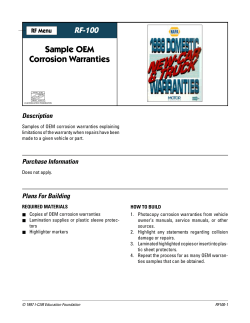
The Corrosion Attack on Stainless Steel 316L and WC
International Conference on X-Rays & Related Techniques in Research & Industry 2014 (ICXRl20 14) The Corrosion Attack on Stainless Steel 316L and WC-Co in High Sulphate-Chloride Ratio Faculty of Mechanical and Manufacturing Engineering, Universiti Tun Hussein Onn Malaysia, 86400 Batu Pahat, Johor, Malaysia Abstract Austenitic stainless steels and cermets alloy has been used extensively in many sectors due to their highly resistance to corrosion attack and excel in mechanical properties. However, in corrosive media both materials are susceptible to corrosion attack especially in seawater and high temperature. Cermet alloys are a combination of ceramic and metal. Therefore, cermets exist in high corrosion resistance in aqueous media ,,and the corrosion rate is complex to identify. This paper presents the corrosion mechanism of SS 3 16L and cermets alloy exposed to high concentration of sulphate in the salinity of seawater. The corrosion mechanism were characterized to breakdown potential (Eb), which are the potential once reaches a sufficiently positive value and also known as pitting potential. The Eb value of SS 3 16L in high sulphate are higher compared to WC-Co which elucidate that some anions such as sulphate behaves as inhibiting effect to SS 316L. Keywords: SS3 16L, Cermets alloy, sulphate, seawater Methodology The electrochemical response during anodic polarisation when the potential is scanned in the positive direction from E,,, (also known as OCP) and only very small ) are currents (typically -40 recorded until Eb, is reached. At this point the current rises rapidly as a function of potential indicating that corrosion attack has initiated. The current corresponding to the breakdown potential is denoted as breakdown current density, ib (A/cm2)). The breakdown potential of the material provides information on the resistance of materials to passivity breakdown [I]. Each anodic polarisation scan was reversed once the current reached a set current (ire,) of 500~A/cm~ The . degree of the increase in current beyond ire, gives an indication of the propensity for corrosion propagation [2]. An indication of the extent of propagation is therefore obtained by which represents the consideration of ,,i maximum current attained should the current not begin to fall immediately after scan reversal. Results and Discussion This experiment was conducted to quantify the effect of sulphate to corrosion attack on SS 3 16L and cermet alloy. For passive alloy including austenitic stainless steels (SS 3 16L), corrosion resistance is provided by a very thin surface film, known as passive film that is an invisible film of oxide, formed by the metal reacting with the ambient environment. The cyclic polarisation performs in positive hysteresis (Fig. 1) indicates that after passive film destroyed, the material does not repair itself. Therefore, the corrosion attack propagates and localised corrosion will start. International Conference on X-Rays & Related Techniques in Research & Industry 2014 (ICXR12074) -3IIL WCCo sulphate causes the The vresence distribkion of availabfe pit sites to be shifted to a higher potential, which causes pit propagation in both metastable and stable states [3]. The pitting observed on SS 3 16L is shown in Fig. 2 and Fig. 3 shows the SEM image of a pit found on SS 3 16L after cyclic polarisation potential test with alongside the EDX element analysis. Fig. 2: Pitting observ Fig. 3: SEMIEDX analysis of pitting on SS 316L For WC-Co, the Open Circuit Potential (OCP) values shifted towards more active values compared to SS 316L, while the breakdown corrosion potential presented the opposite tendency (Fig I). The SEM observed on WC-Co surface found that corrosion product developed during electrochemistry occluded on WC-Co and protect from hrther corrosion attack as shown in Fig 4. WIG-co surface. For passive materials such as SS 3 16L, anions such as C10i and C1- lead to formation of strong acids inside the pits [4]. The pit begins to grow after the passivating film is broken down at some weak site. Therefore, the concentration of C1- within the pits at first increases and gradually decrease because of tightness of the film covered which is facilitates to convective and diffusive mixing of the solution inside the pits and in their surroundings. Non uniform of distribution of current density and C1- concentration in the pits and time dependent showed by the shape of pits changing from hemispherical to cup-like. The morphology of the pit indicates that it was extended and deepened during the propagation. This pit has already reached the critical size and the lacy cover is destroyed, resulting in an open hemispherical cavity. The EDX results have peaks of sulphur and oxygen, which proves that sulphide inclusion play a key role in pitting initiation on SS 316L, notably at particles physically associated with oxides. References 1. Roberg P.R., Corrosion engineering: Principles and practice: McGraw-Hill, 2008, pp 5, 169-177. 2. KamachiI U. M., Corrosion Science and Technology:Mechanism, Mitigation and Monitoring 2009, Mumbai: narosa publishing house. 3. Smialowska Z., EfSect of the ratio of C1/sod2- in solution on the pitting corrosion of Ni. Corrosion Science, 1971. ll(4): p. 209-221
© Copyright 2025












